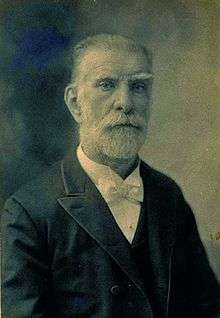Adolf Cluss
| Adolf Cluss | |
|---|---|
 Adolf Cluss, 1900 | |
| Born |
July 14, 1825 Heilbronn, Germany |
| Died |
July 24, 1905 (aged 80) Washington D.C., United States |
| Nationality | German-born American |
| Occupation | Architect |
| Buildings |
Arts and Industries Building |
Adolf Cluss (July 14, 1825 – July 24, 1905) was a German-born American immigrant who became one of the most important architects in Washington, D.C., in the late 19th century, responsible for the design of numerous schools and other notable public buildings in the capital.
Life
He was born in 1825 in Heilbronn in the Kingdom of Württemberg in south-west Germany.[2] His father was a master builder, and young Cluss set out as an itinerant carpenter when he left Heilbronn at age nineteen. In his travels, he met and became a friend of Karl Marx and a supporter of communist principles at a time of political and revolutionary ferment in Germany. He joined the Communist League and became a member of the Mainz Worker Council. The failure of the German revolutionary movement in 1848 led him to leave Germany when he was twenty-three, along with other Forty-Eighters who emigrated to the United States at that time. In the United States, he continued his political activity into the 1850s, maintaining an extensive correspondence with Marx and Engels and writing and publishing political articles for the German-American community.[3]
Settling in Washington, D.C., Cluss also began building a highly successful practice as an engineer and architect. In the following decades, from the 1860s to the 1890s, he was responsible for designing scores of major public buildings, including at least eleven schools, as well as markets, government buildings, museums, residences and churches. By 1872, he had become City Engineer and a member of the Board of Public Works, overseeing some of the civic improvements that transformed Washington in the 1870s: street paving, sewer construction, and the planting of thousands of street trees.[4]

Cluss's schoolhouse designs were particularly innovative and influential, though only two of his red-brick school masterpieces remain, Franklin School and Sumner School in downtown Washington. The Franklin School was completed in 1869 earning the Washington public school system a Medal for Progress.[5] He designed four major buildings on the National Mall, including the still-standing Smithsonian Arts and Industries Building. He built six houses of worship, including Calvary Baptist Church, located at 777 8th Street, N.W.
Two of the city's major food markets, Center Market and Eastern Market, were built to his design, the latter surviving and restored to use after a disastrous 2007 fire. His flagship store for Lansburgh's opened in 1882.[6]
Cluss was also active as a builder of mansions for the Washington elite, such as Stewart's Castle on Dupont Circle. In 1880, he was hired to create what became Washington's first apartment building, Portland Flats, an ornate, six-floor, 39-unit creation on the south side of Thomas Circle. Almost all of Cluss' residential creations have been demolished—Portland Flats, for instance, was torn down in 1962 to make way for an office building.[7]
Red brick was Cluss' favorite building material; that, and his early communist sympathies, led some to dub him the "Red Architect", though he was a man who in later life became a confirmed Republican.[8]
A descriptive list of Cluss's known buildings and an interactive map showing their locations can be found here.[9]
Notes
- ↑ https://www.washingtonpost.com/lifestyle/magazine/seeking-a-little-solitude-find-it-in-northeasts-brookland-and-nearby/2015/12/16/2238ca9e-9236-11e5-8aa0-5d0946560a97_story.html
- ↑ Adolf Cluss Exhibition Project http://www.adolf-cluss.org/
- ↑ Benjamin Forgey. 'Red Architect' Adolf Cluss: A Study in Sturdy. http://www.washingtonpost.com/wp-dyn/content/article/2005/09/16/AR2005091601904.html
- ↑ Goethe-Institut http://www.goethe.de/ins/us/was/pro/vtour/dc1/clussbio.htm
- ↑ Moeller Jr., G Martin. Guide to the Architecture of Washington, D.C. The Johns Hopkins University Press, 2006. Page 11
- ↑ National Park Service http://www.nps.gov/history/nr/Travel/wash/dc85.htm
- ↑ Then and Now: The Portland Flats http://greatergreaterwashington.org/post.cgi?id=2267
- ↑ Forgey; http://www.washingtonpost.com/wp-dyn/content/article/2005/09/16/AR2005091601904.html
- ↑ Cluss-Buildings - the Red Brick City around 1900 at www.adolf-cluss.org
External links
| Wikisource has original works written by or about: Adolf Cluss |
| Wikimedia Commons has media related to Adolf Cluss. |
- Adolf Cluss, An International Exhibition Project
- Goethe-Institut in Washington, DC: Notes on Adolf Cluss
- Washington Post: "Red Architect" Adolf Cluss
- "Adolf Cluss (1825-1905), Architect: From Germany to America", Goethe Institute newsletter, June 2009
- http://www.adolf-cluss.org/